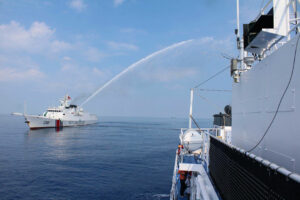
Analyst tells Philippines not to rule out using water cannons vs Chinese vessels
By Kyle Aristophere T. Atienza, Reporter
THE PHILIPPINES should never rule out the use of water cannons and other non-lethal means in defending its features in the South China Sea so as not to give China room to step up its expansionism, a geopolitical expert said.
“Keeping options open for the use of water cannons or other form of non-lethal means for self defense should not be completely ruled out, given Beijing’s unwillingness to tone down its provocations,” Don Mclain Gill, an international relations lecturer at De La Salle University, said in a Facebook Messenger chat.
“Moreover, keeping such options open will not compromise the Philippines’ defense-oriented position, but will merely be an additional layer of non-lethal defense.”
On Monday, President Ferdinand R. Marcos, Jr. said the Philippines would never fire water cannons against Chinese Coast Guard (CCG) vessels in the South China Sea in retaliation to avoid worsening tensions.
Following China’s recent action of firing water cannons at Philippine government-contracted boats delivering supplies to a Navy outpost at Second Thomas Shoal — which has drawn international condemnation — Senator Aquilino Martin L. Pimentel, III suggested that the Philippine Coast Guard (PCG) equip its vessels with water cannons.
“Even if equipped with water cannons, the Philippines faces the issue of being overmatched by China’s large and numerous coast guard and militia ships,” said Raymond M. Powell, SeaLight director at the Gordian Knot Center for National Security Innovation at Stanford University.
“While the Philippines would be perfectly justified in returning fire with its own water cannons, in most cases it would not be able to overcome the mass of ships China would be able to throw into a fight,” he added.
The PCG has accused its Chinese counterpart of deliberately escalating the tension after firing jet stream water cannons against its ship and another owned by the fishery bureau on April 30 in the waters of Scarborough Shoal, which also falls within Manila’s exclusive economic zone (EEZ).
Mr. Gill said Manila needs to predict how retaliating through non-lethal force such as water cannons will figure in China’s calculations. “If China puts a cap on its escalation, this will allow the Philippines and its partners to better assess how to deal with Beijing with less uncertainty.”
The Philippines has a mutual defense treaty with the United States, and experts have said China’s use of water cannons is a form of harassment that stops short of a military confrontation but gets the job done nonetheless in terms of establishing control over a geographical space.
Mr. Gill expects China to continue to exploit water cannon use and other tactics that may not be deemed as acts of war given its acknowledgement of the implications of a potential activation of the defense treaty.
“While more water cannons, vessel damage, and ramming may be anticipated, it is also crucial to understand that China will only seek to escalate to a certain degree given its acknowledgement of the implications of utilizing the Mutual Defense Treaty with the US if Filipino crew members were to suffer a fatal casualty,” he said.
“However, such measures also involve a lot of strategic risks and potentials for miscalculation,” he added. “On the contrary, however, by not adding such additional layers, continuity in China’s provocations will likely be the expected scenario.”
Mr. Powell said the Marcos administration’s approach “recognizes the force imbalance” and instead adopts a non-violent direct action, “which has been used successfully in places like colonial India and the segregated South in the US to draw attention to powerful, immoral oppressors.”
The PCG had said its ship incurred over P2 million in damages due to Chinese action on April 30, noting that it was “evidence of the forceful water pressure used by the China Coast Guard in their harassment of the Philippine vessels.”
Armed Forces of the Philippines chief Romeo S. Brawner, Jr. last year said China was using its coast guard instead of its Navy force to harass Filipino vessels because “they want to act short of declaring war.”
He said the Chinese Coast Guard is not a civilian agency because it is under China’s Central Military Commission, adding that an attack, even with just a water cannon, on a Navy ship could be interpreted “as an act of war already.”
Last December, Mr. Brawner was aboard a Philippine resupply boat that was hit by water cannons fired by the Chinese Coast Guard.
The PCG was under the Department of National Defense before it was transferred to the Office of the President on March 30, 1998 through an order issued by the late President Fidel V. Ramos. Less than a month later, Mr. Ramos transferred the PCG to the Department of Transportation and Communications, which was split into two into separate agencies in 2016 through a law signed by the late former president Benigno S. Aquino, III.



